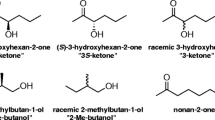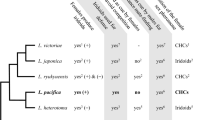Abstract
Seventeen species ofIps were laboratory or field tested for the specificity of their response to male-produced aggregating pheromones. In the laboratory, some species appeared not to differentiate among their own pheromones and those of closely related species, whether the pheromones were bioassayed individually or in direct competition. Other species showed strong preference for their own pheromones in competition with those of closely related species, even though they had demonstrated strong attraction to pheromones of the related species. Cross-responsiveness amongI. confusus, I. montanus, andI. paraconfusus, and betweenI. mexicanus andI. concinnus, was confirmed in field tests. Moreover, wildI. paraconfusus females entered the nuptial chambers of males ofI. montanus andI. confusus but not those of the more distantly relatedI. mexicanus. It is hypothesized that specificity of response to aggregating pheromone is important in the maintenance of reproductive isolation among sympatricIps and that the lack of specificity among closely related species enforces the parapatric distributions characteristic of these species.
Similar content being viewed by others
References
Bedard, W.D., andBrowne, L.E. 1969. A delivery-trapping system for evaluating insect chemical attractants in nature.J. Econ. Entomol. 62:1202–1203.
Birch, M.C., andWood, D.L. 1975. Mutual inhibition of the attractant pheromone response of two species ofIps.J. Chem. Ecol. 1:101–113.
Borden, J.H. 1967. Factors influencing the response ofIps confusus (Coleoptera: Scolytidae) to male attractant.Can. Entomol. 99:1164–1193.
Hopping, G.R. 1963. The natural groups of species in the genusIps De Geer (Coleoptera: Scolytidae) in North America.Can. Entomol. 95:508–516.
Hopping, G.R. 1965. North American species in group IX ofIps De Geer (Coleoptera: Scolytidae).Can. Entomol. 97:422–434.
Lanier, G.N. 1967. Biosystematic, cytological, and sex ratio studies of closely related bark beetles (Coleoptera: Scolytidae). Ph.D. Thesis, University of California, Berkeley.
Lanier G.N. 1970a. Sex pheromones: abolition of specificity in hybrid bark beetles.Science 169:71–72.
Lanier, G.N. 1970b. Biosystematics of North AmericanIps (Coleoptera: Scolytidae). Hopping's Group IX.Can. Entomol. 102:1139–1163.
Lanier, G.N. 1970c. Biosystematics of the genusIps (Coleoptera: Scolytidae) in North America. Hopping's Group III.Can. Entomol. 102:1404–1423.
Lanier, G.N. 1972. Biosystematics of the genusIps (Coleoptera: Scolytidae) in North America. Hopping's groups IV and X.Can. Entomol. 104:361–388.
Lanier, G.N., andBurkholder, W.E. 1974. Sex pheromones in the speciation of Coleoptera. Pages 116–189,in Birch, M.C. (ed.), Pheromones. Elsevier, North Holland.
Lanier, G.N., andCameron, E.A. 1969. Secondary sex characters in the North American species of the genusIps De Geer (Coleoptera: Scolytidae).Can. Entomol. 101:862–870.
Lanier, G.N., Birch, M.C., Schmitz, R.F., andFurniss, M.M. 1972. Pheromones ofIps pini (Coleoptera: Scolytidae): variation in response among three populations.Can. Entomol. 104:1917–1923.
Lindquist, E.E. 1969. Review of holarctic tarsenemid mites (Arcarina: Prostigmata) parasitizing eggs of Ipine bark beetles.Mem. Entomol. Soc. Can., No. 60.
Piston, J.J., andLanier, G.N. 1974. Pheromones ofIps pini (Coleoptera: Scolytidae). Response to interpopulational hybrids and relative attractiveness of males boring in two host species.Can. Entomol. 106:247–251.
Renwick, J.A.A., andVité, J.P. 1972. Pheromones and host volatiles that govern aggregation of the six-spined engraver beetle,Ips calligraphus.J. Insect. Physiol. 18:1215–1219.
Silverstein, R.M., Rodin, J.O., andWood, D.L. 1966. Sex attractants in frass produced by maleIps confusus in ponderosa pine.Science 154:509–510.
Vité, J.P., andGara, R.I. 1962. Volatile attractants from ponderosa pine attacked by bark beetles (Coleoptera: Scolytidae).Contrib. Boyce Thompson Inst. 21:251–273.
Vité, J.P., andRenwick, J.A.A. 1971. Population aggregating pheromone in the bark beetle,Ips grandicollis.J. Insect Physiol. 17:1699–1705.
Vité, J.P., Bakke, A., andRenwick, J.A.A. 1972, Pheromones inIps (Coleoptera: Scolytidae): occurrence and production.Can. Entomol. 104:1967–1975.
Vité, J.P., Gara, R.I., andVon Scheller, H.D. 1964. Field observations on the response to attractants of bark beetles infesting southern pines.Contrib. Boyce Thompson Inst. 22:461–470.
Wilkinson, R.C. 1964. Attraction and development ofIps bark beetle populations in artificially infested pine bolts exposed on fire towers and turntables in Florida.Florida Entomol. 47:57–64.
Wood, D.L. 1970. Pheromones of bark beetles, pp. 301–316,in D. L. Wood, R. M. Silverstein, and M. Nakajima (eds.), Control of insect behavior by natural products. Academic Press, New York.
Wood, D.L. 1972. Selection and colonization of ponderosa pine by bark beetles,in Insect/Plant Relationships, H. F. van Emden (ed.).Symp. R. Entomol. Soc. 6:101–117.
Wood, D.L., andBushing, R.W., 1963. The olfactory response ofIps confusus (LeConte) (Coleoptera: Scolytidae) to the secondary attraction in the laboratory.Can. Entomol. 95:1066–1078.
Wood, D.L., Browne, L.E., Silverstein, R.M., andRodin, J.O. 1966. Sex pheromones of bark beetles. I. Mass production, bioassay, source, and isolation of the sex pheromone ofIps confusus (LeC.)J. Insect Physiol. 12:523–536.
Wood, D.L., Stark, R.W., Silverstein, R.M., andRodin, J.O. 1967. Unique synergistic effects produced by the principal sex attractant compounds ofIps confusus (LeConte) (Coleoptera: Scolytidae).Nature 215:206.
Young, J.C., Silverstein, R.M., andBirch, M.C. 1973. Aggregation pheromones of the bark beetleIps confusus: Isolation and identification.J. Insect Physiol. 19:2273–2277.
Author information
Authors and Affiliations
Additional information
Study supported in part by the National Science Foundation (GB 2972), U.S. Forest Service (No. 5), California Division of Forestry, T. B. Walker and Surdna Foundations, and various forest industries.
Rights and permissions
About this article
Cite this article
Lanier, G.N., Wood, D.L. Specificity of response to pheromones in the genusIps (Coleoptera: Scolytidae). J Chem Ecol 1, 9–23 (1975). https://doi.org/10.1007/BF00987717
Issue Date:
DOI: https://doi.org/10.1007/BF00987717




